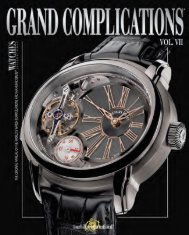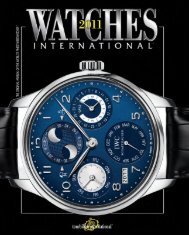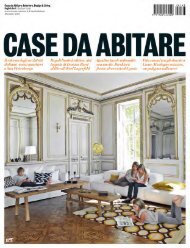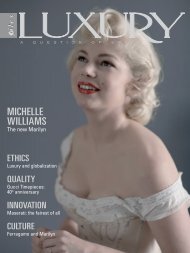180 YEARS OF
180 YEARS OF
180 YEARS OF
Create successful ePaper yourself
Turn your PDF publications into a flip-book with our unique Google optimized e-Paper software.
WATCH HISTORY | e Milestones<br />
1932<br />
One Watch,<br />
Two Dials<br />
DUO DIAL<br />
e Great Depression in the early<br />
1930s took a toll on Longines, where<br />
workers were obliged to accept a<br />
20- percent wage reduction, higherranking<br />
employees’ salaries were<br />
slashed by 30 percent and executives’<br />
paychecks shrank by fully 40 percent.<br />
In this crisis-fraught era, Longines put<br />
its hopes in a new product designed to<br />
combine functionality and elegance.<br />
It had become fashionable in the 1930s<br />
for wristwatches to display the hours<br />
and minutes in the upper portion, and<br />
the seconds in the lower part, of rectangular<br />
dials, but Longines wanted to<br />
do more than merely follow the<br />
decrees of fashion. e brand put the<br />
crowning touch on this type of display<br />
by creating a case with two separate<br />
windows. is not only made a new<br />
impression, but also reduced the danger<br />
of breakage for the fragile crystals.<br />
Of course, a wristwatch of this sort<br />
called for a special movement. e<br />
work of developing the elongated,<br />
rectangular (26.6 x 15.5 mm), handwound<br />
Caliber 9.32 began early in<br />
1932. A shock-absorption system safeguarded<br />
the pivots of the balance sta<br />
against breakage. e large screw balance<br />
and self-compensating Breguet<br />
hairspring oscillated at a frequency of<br />
18,000 vph. e rectangular case, with<br />
engraved indices around the windows,<br />
was available in various materials.<br />
Longines targeted as potential<br />
customers for this watch physicians,<br />
nurses, scientists and everyone else<br />
who needed a watch that clearly displayed<br />
the passing seconds. Alongside<br />
this avant-garde model, there was also<br />
a conventional open version.<br />
1938<br />
Quick<br />
Return<br />
STOP SECONDE<br />
An elapsed-seconds hand that can be<br />
started, stopped and returned to zero<br />
independently of the ordinary time<br />
display is among the most salient<br />
features of every chronograph.<br />
Whether this hand sweeps its<br />
circles from the center of the<br />
main dial or across the plane of<br />
a subdial matters little, and the<br />
presence or absence of counters<br />
for elapsed minutes and<br />
elapsed hours is also unimportant.<br />
Less complex than the other<br />
chronographs, which Longines produced<br />
in great variety, was Caliber<br />
12.68Z Stop, a 17-jewel movement that<br />
the brand launched in 1938. The number<br />
“12” in this caliber’s name stood for<br />
its diameter: 12 lignes or 27 millimeters.<br />
A button at 2 o’clock triggered the central<br />
elapsed-seconds hand to quickly return<br />
to its zero at the user’s command.<br />
This quick return, now known as a flyback<br />
function, was accomplished by<br />
connecting the trigger button to a zeroreturn<br />
lever on the classic zero-return<br />
heart of the central elapsed-seconds<br />
hand. Horizontal coupling created the<br />
connection to the fourth wheel. The<br />
chronograph could not be stopped; its<br />
user had to be satisfied with restarting<br />
it at the correct time. A version of the<br />
caliber was also available with a simple<br />
stop-seconds function; another, with an<br />
additional 60-minute counter (also from<br />
the center; see illustration), debuted in<br />
1939. The Stop Seconde was available<br />
in elegant and sporty models.

















